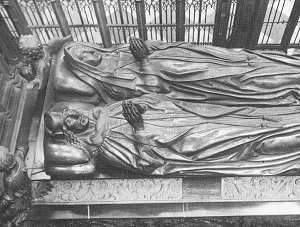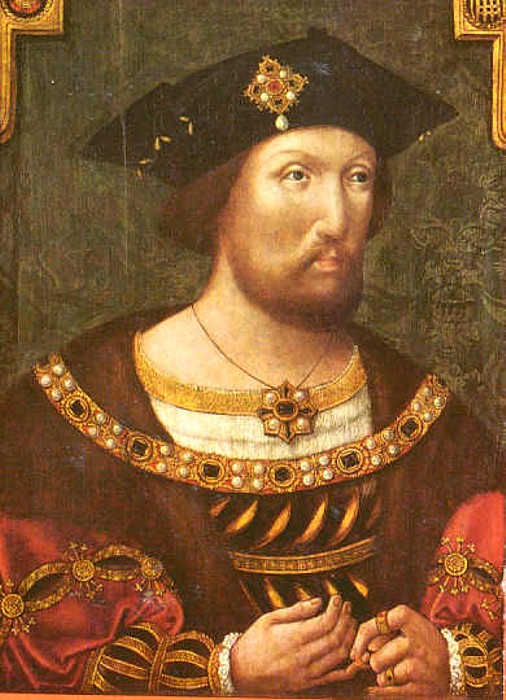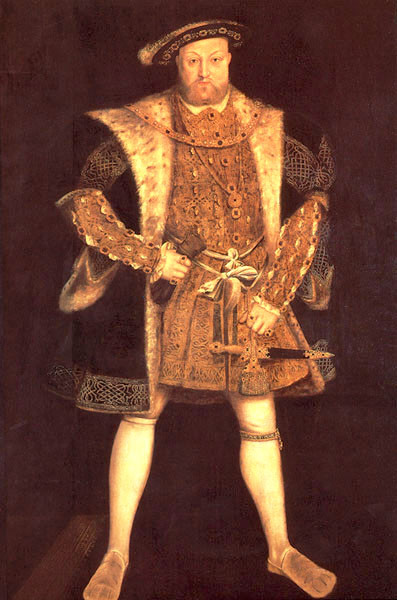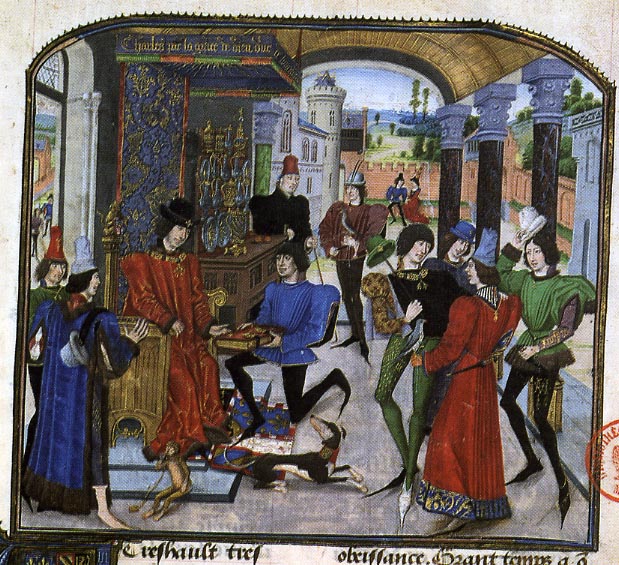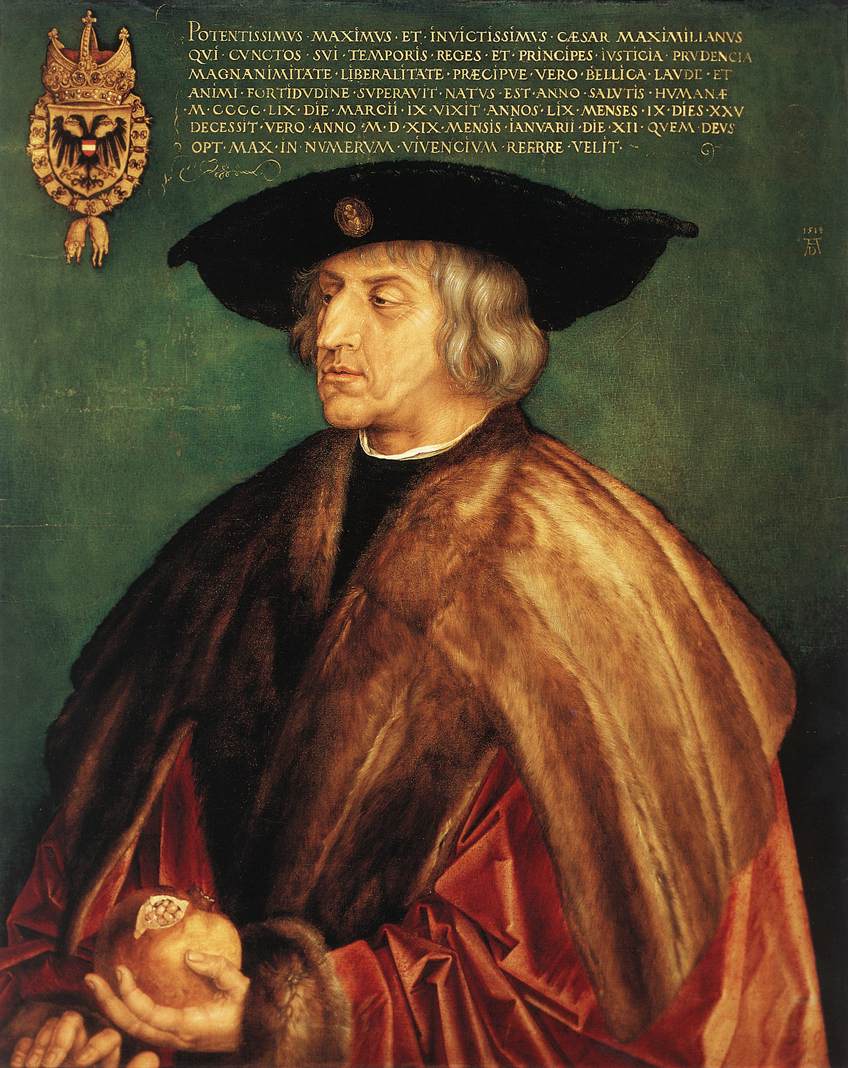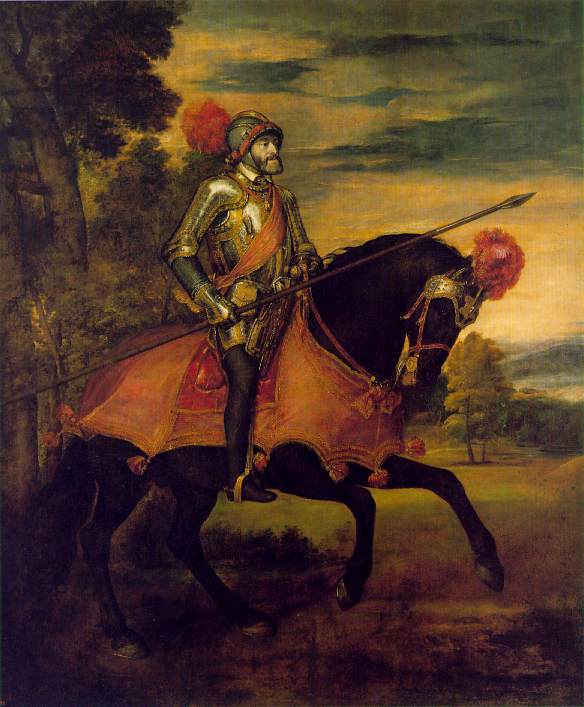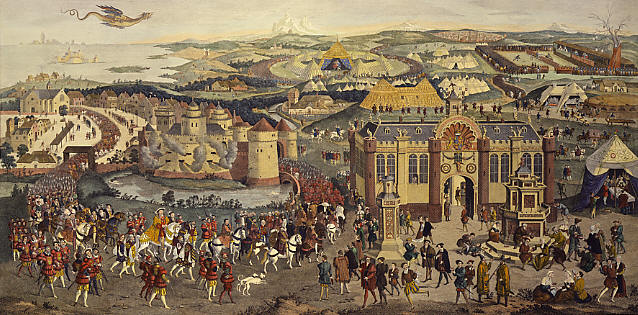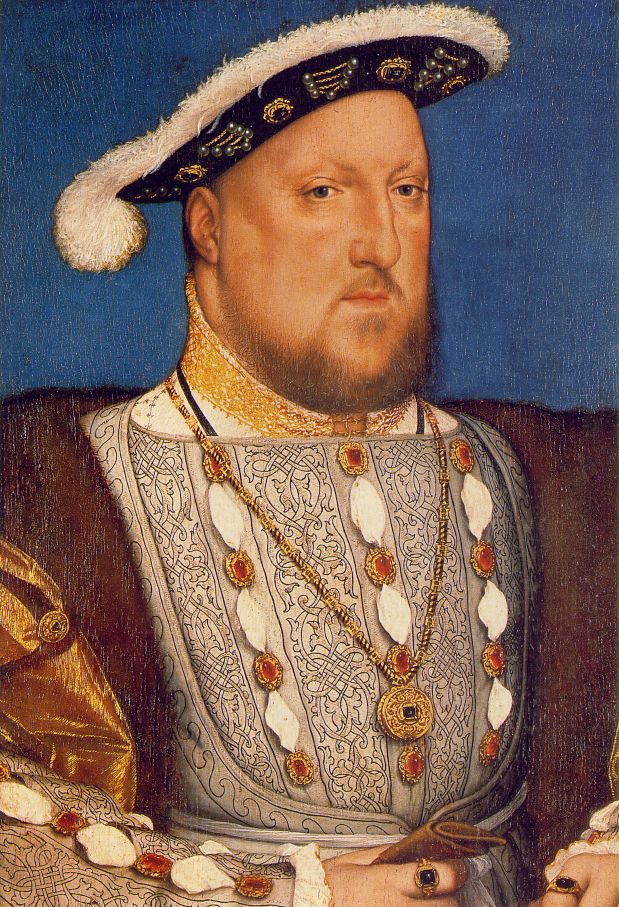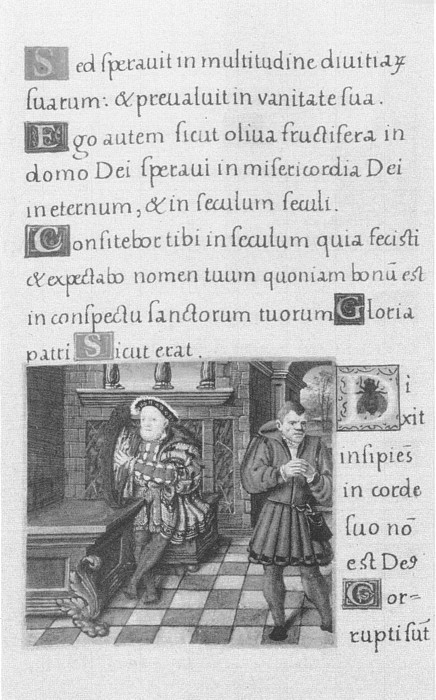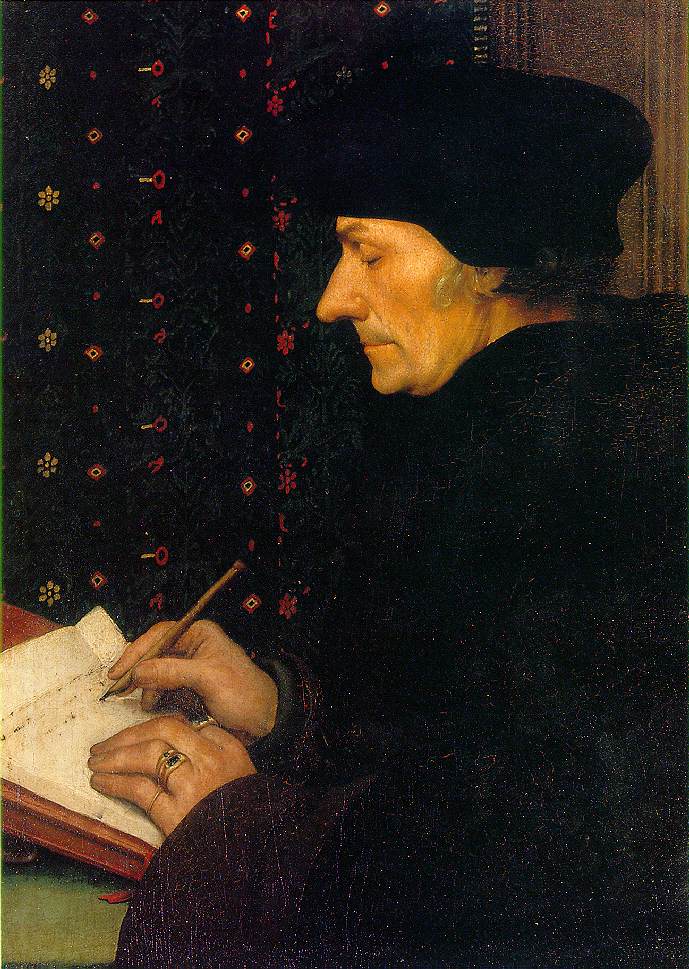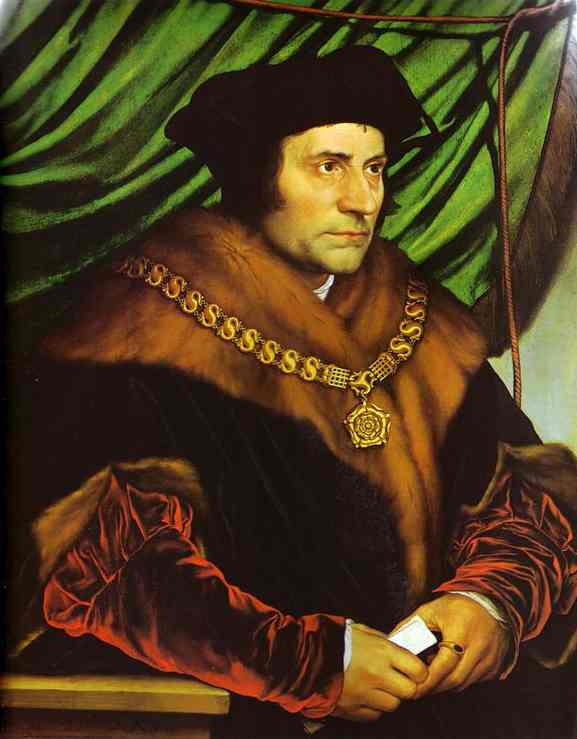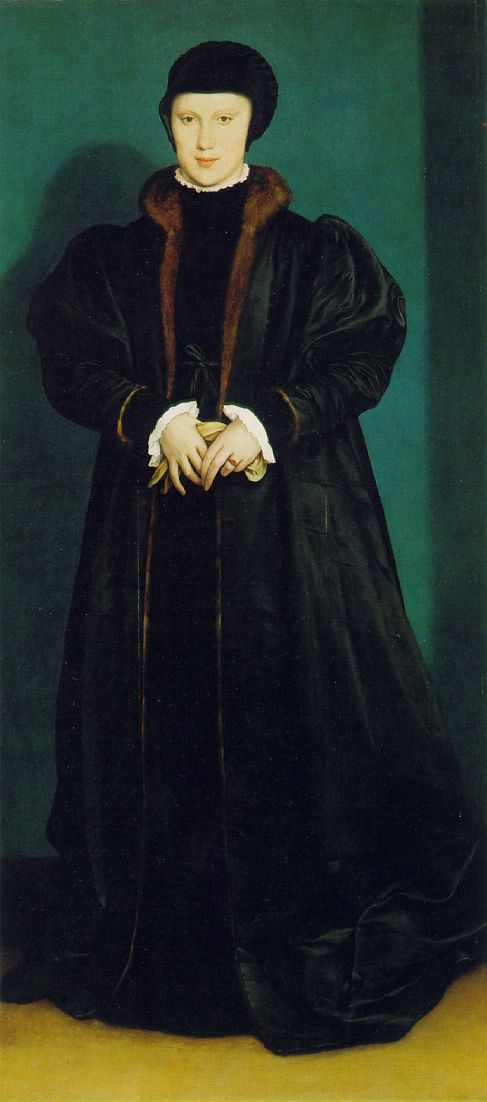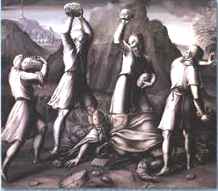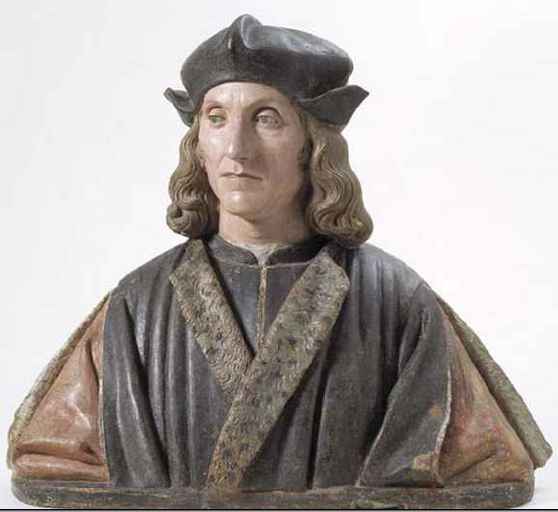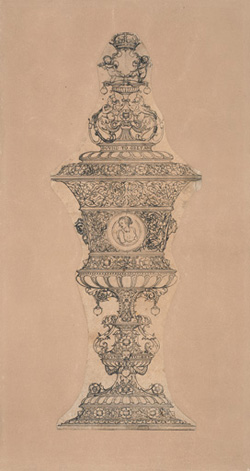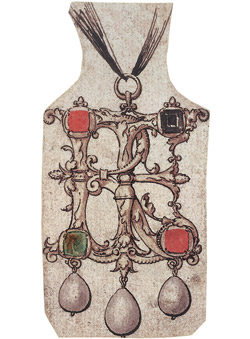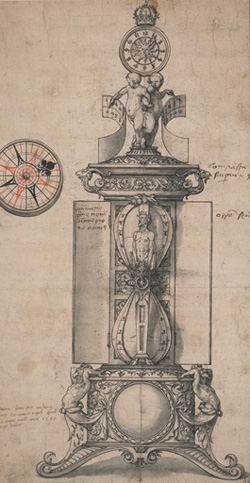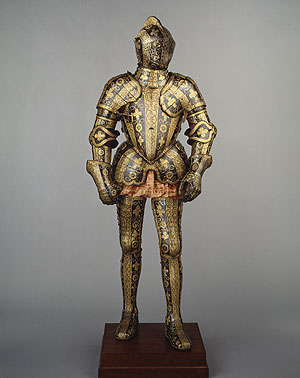These notes deal principally with the reign of Henry VIII and Elizabeth but the Tudor dynasty began with Henry VII when he won the crown in battle (killing Richard III at the Battle of Bosworth Field on 22 August 1485). He had a weak claim to the throne through the female line but consolidated his power and ended the war between the Yorkists and Lancastrians by marrying Elizabeth of York. The symbol representing this union was the Tudor rose, a large red Lancastrian rose surrounding a small white Yorkist rose.
One of the early pictures (1505-9, Royal Collection) shows Henry VII and Elizabeth of York being united by an angel with St. George (patron saint of England and the Order of the Garter) above killing a dragon. It is a good illustration of how art was used as propaganda by making a dynastic statement. In this case the ancestors of Henry VII are shown behind him in decreasing order of size. His son Arthur died in 1502 (aged 16), Henry lived to be king and his only other son Edmund died in 1500 aged 1. Of his daughters only Margaret lived to adulthood and married James IV of Scotland and their son was James V and his son was James VI, who became James I of England.
The painting is covered in heraldic devices such as the portcullis, the personal emblem of Lady Margaret Beaufort, Henry VII’s mother. The white fur they are wearing could only be worn by nobility and enforced by sumptuary laws although by this stage they were frequently broken as merchants got richer and could afford to dress like nobles. In the 16th century the first thing people would notice in a picture like this is the heraldic devices and even humble people could recognise coats of arms.
Henry VII died in 1509 and Henry VIII erected a gilt bronze tomb in Westminster Abbey.
This is a portrait by an unknown artist of Henry VIII, c. 1520. He is looking young and fit unlike his appearance in later portraits by Holbein. Towards his death he developed an ulcer on his leg as a result of a hunting accident and could not walk so he became very fat and even needed a hoist to be lifted into bed.
At his death he had 55 palaces and no monarch has ever had so many before or since. He was a scholar and had many libraries, the library at Whitehall alone had 1,450 books.
This is a famous image of Henry VIII and is a copy of a picture by Holbein that has been destroyed.
Magnificence
Henry started to spend on the arts (unlike his father) as part of the doctrine of magnificence. This had a more precise meaning at the time and it was considered a requirement of the monarch to spend more than anyone else to demonstrate their status. It also created jobs, in the 1530s Hampton Court was a building site for 15 years. This contemporary quote makes it clear:
Sir John Fortescue, The Governance of England (c. 1470) [quoted in S. Thurley, The Royal Palaces of Tudor England (1993), p.11]:
Item, it shall nede that the kyng have such tresour, as he mey make new bildynges whan he woll, ifor his pleasure and magnificence; and as he mey bie hym riche clothes, riche furies. . . rich stones… and other juels and ornaments convenyent to his estate royall. And often tymes he woll bie rich hangynges and other apparell ifor his howses. . . for yff a king did not so, for myght do, he lyved then not like his estate, but rather in miserie, and more in subgeccion than doth a private person.
Henry VI (1421-71, pious, indecisive, easily-led, mentally unstable from 1543, troubled finances) was criticised for not making sufficient outward display of magnificence, he often wore plain black and dark clothes, and this was not what was expected of a monarch. However Henry VI was so weak and the country so troubled that there could be many other reasons to criticize him.
New foreign ideas of the classical were coming over in the late 15thC and early 16thC (before Holbein, not because of Holbein). These ideas were brought back by English clerics who studied at Italian universities, such as Padua and brought back Italian manuscripts.
Charles the Bold of the Burgundian Court illustrating a bureau stacked with gold plate.
The doctrine of magnificence actually goes back much further to Aristotle and it never disappeared in medieval times. Magnificence was important politically both domestically and internationally. Domestically it showed how much money you had. One story is that Charles the Bold avoided an uprising by inviting the rebels and greeting them after they had walked through rooms stacked with gold plate. Armies were raised by melting down gold plate for cash as there were no banks gold plate was a good way to store wealth. Unfortunately this means that little gold plate has survived. Gold plate was stacked many levels high on bureaux as shown above. The Burgundian Court had a strong influence on the Tudor Court as there were close trade and political ties between the two.
Internationally Henry VIII’s rivals were Maximillian (by Durer, 1519), Holy Roman Emperor.
The Holy Roman Empire was the superpower of Europe along with France, they were each much larger and wealthy than England. Maximillian was succeeded by
Charles V in 1819.
Charles V on Horseback, Titian, 1528.
The other great European monarch was Francois I, King of France, shown here by Jean (d. 1541) and Francois Clouet (1510-72), 1548. Francois’s dates were similar to Henry VIII, born 1594 (Henry 1491), king 1515 (Henry 1509) and died 1547.
Unknown artist, Field of the Cloth of Gold, 1520s
Henry and Francois met in France at the Field of the Cloth of Gold held in 1520. England still owned Calais, which was not lost until Mary’s reign in the 1550’s.
The encampment included a temporary palace two storey’s high built partly of brick, wood and canvas with real glass windows. The landscape was flattened so that when Henry and Francois walked to met each other they would remain on the same level. The tents were made of fabric with gold thread accounting for the name. Although Wolsey (the manager of the project) was criticised in 1529 for profligate expenditure on a temporary structure this was only to pile on more charges to the falling Wolsey. The Field of the Cloth of Gold was a prime example of magnificence where each king was trying to outdo the other in what we would call extravagance.
England was much smaller than France in terms of land mass, population and wealth so by spending lavishly Henry was punching above his weight and making his mark in Europe. In reality Henry’s only European political power was as a pawn that could sway the balance of forces between France and the Holy Roman Empire by aligning with one or the other, which he did frequently.
How could Henry VIII afford this expenditure? The dissolution of the monasteries provided a fortune that had previously gone to Rome. It also started a building boom, perhaps the greatest England has ever seen. As lesser and greater nobility were given land that had previously belonged to the Church they wanted a house to live in and so country houses were built all over the country. Fountains Abbey in Yorkshire gives an indication of this enormous wealth as it was a minor abbey but it was enormous. It is estimated that Henry seized lands worth £1.3m in 16thC money.
In Spain Charles V was also King of Spain but after his death in the second half of the 16thC it was inherited by Philip II who was not made Holy Roman Emperor. Philip took over the southern part of the Netherlands and married Mary I.
Henry VIII wanted to create a new court that was impressive at the European level after the wars of the 15thC when England had no time to deal with Europe. It seems he succeeded, the following letter was written as a private letter, that is the writer had no need to flatter:
Letter from the Papal Nuncio to Isabella d’Este, marchioness of Mantua, 1517 [quoted in D. Starkey (ed.), Henry VIII A European Court in England (1991)]: In short, the wealth and civilization of the world are here, and those who call the English barbarous appear to me to render themselves such. Here I perceive very elegant manners, extreme decorum, and there is this most invincible king…
Henry was multi-talented, a sportsman, scholar, he played the lute, and composed.
Baldassare Castiglione wrote the Book of the Courtier and was the spokesman for a cultural revolution taking place across Europe. Formally, nobility’s job was to support the king in times of war and between wars they could do what they wanted and most hunted although a few also wrote poetry. However, in the 16thC a nobleman needed to be much more, it was expected that they were educated and a good all rounder, a Renaissance man. They went to university, had a classical education in the liberal arts, grammar, moral philosophy and the classics – studia humanitatis, from which we get the humanities. Henry VIII could read Latin, unlike most previous monarchs and Elizabeth Italian, French, Spanish, Latin and some Greek. More universities were opened in the 16thC than any other.
Why did this change take palace? The nation was becoming increasingly complex to administer with the general increase in wealth, and increasingly centralised. This meant an expanding
bureaucracy that needed talented people to run it. A classical education prepares you for a job in administration, or so it was thought and this belief continues even to today. It became possible to rise through merit.
There was an international network of scholars, such as Erasmus and More.
Holbein, Erasmus, 1523.
Scholars travelled, for example, Erasmus visited Cambridge and became a professor of Divinity.
Holbein, Portrait of Sir Thomas More, 1527. More was a typical product of this generation, from a minor family but he had a full classical education at Oxford and then studied to become a lawyer (like Tony Blair today). More went on to became Lord Chancellor. Thomas Wolsey was the
son of a butcher and became Cardinal, Lord Chancellor and he even fancied his chances at becoming Pope. The visual arts enabled someone from a minor family to adopt the trappings of nobility.
Nonsuch Palace (formerly in Nonsuch Park in Cheam, Surrey) was a great house built by Henry from scratch. Now only a few foundations survive and there is a small display in the Museum of London. It was flattened by a mistress of Charles II as she considered it old-fashioned. It had a comprehensive programme of classical learning embedded in its decoration.
In 1542 and 1547 two complete inventories of everything Henry owned were taken and it is currently being published (it is only in the Warburg library). It describes his belongings room by room, palace by place. It is almost as if he had just walked from the room as it lists many glasses cases but few glasses, just like today when we walk off with our glasses and forget the case. It shows the obsession with heraldry, even the chamber pot had a Tudor rose on it. Every painting is listed, including religious paintings, such as Virgin and Child, but of all these only two survive.
Holbein’s Christina of Denmark, Duchess of Milan, which he always kept with him.
Attributed to Girolamo da Treviso, ‘The Evangelists stoning the Pope’, 1540s. This is royal anti-papal propaganda showing the four evangelists stoning the Pope, based on the stoning of St. Stephen but to show the Pope is not St. Stephen he is on the ground with two women representing hypocrisy and avarice.
Sculpture
Sculpture was called “pictures in earth” as the Italian word terracotta that we now use was not yet in use. This is a bust of Henry VII.
Tapestry
At the beginning of the 16thC paintings had a very low status but foreign ideas of valuing paintings slowly became taken on in England. The cost of the materials is very low, a wooden board (or later even cheaper canvas) covered in pigments. It was therefore not ‘magnificent’. The Tudors looked at other art forms such as tapestries, goldsmith’s work. In illuminated manuscripts of the time we see the walls covered in rich tapestries often threaded with gold and silver. Henry had more tapestries than anyone else and the Abraham tapestries at Hampton Court cost over £2,000. There was a tapestry factory in England, the precursor to the Mortlake factory set up by James I, but all the best tapestries were Flemish.
There was another type of wall hanging which was a painted cloth made to look like a tapestry but very few survive as painted cloth is liable to rot. Two are at Hardwick Hall and the borders
mimic those of tapestries.
Goldsmith’s Work
The Jane Seymour gold cup design is in the Holbein exhibition at the Tate. Holbein also designed girdle books which were prayer books that hung at the waist.
Holbein also designed jewellery and there are designs at the Tate exhibition.
There is a clock salt design and also one of the few remaining gold Tudor objects, Henry VIII’s clock salt.
The portrait of Henry VIII at the exhibition is the only original Holbein of Henry VIII that survives.
There were jewels and enamel, such as Diana and Acteon (image not found).
Armour
The other work of art was armour. This suit of armour is Elizabethan and was made for the Earl of Cumberland and is at the Metropolitan Museum. The cost was enormous, this cost as much as one year’s salary for a nobleman. It is inlaid with gold, a real demonstration of magnificence.

